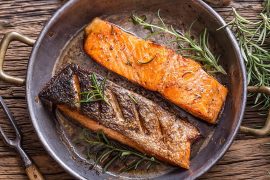Chia seeds, avocado, quinoa – if you want to eat healthy, you can hardly avoid these so-called superfoods. Because of their health-boosting ingredients, they are trendy – but they are facing competition from local “classics”, which often have even greater benefits!
Homemade superfoods: Protect the environment and are good for your wallet
There are many foods in our region that are healthier, contain valuable nutrients and, above all, are more sustainable because there are no long transportation routes to travel.
Sometimes homemade food even surpasses trendy superfoods when it comes to nutrients! Black currants contain almost ten times more vitamin C than the trendy goji berry, which is specially imported from China.
The fact that neighborhood products are usually cheaper than their foreign counterparts is also a solid argument.
Better than avocado, chia and company? Our top choices:
Household benefits: Walnuts instead of avocado
Well, dear avocado – you are great when it comes to unsaturated fatty acids, but the nut has even more of it: 100 g contains 7.5 g of the particularly healthy alpha-linolenic acid – unbeatable!
Walnuts also contain abundant vitamins and minerals: The high potassium content supports muscles and nerves. What makes walnuts even more attractive: They can grow well in our latitudes and last much longer than the quickly rotting and long-lasting avocado.
Classic: Flax seeds instead of chia seeds
Chia seeds come primarily from South and Central America and are rich in omega-3 fatty acids, high-quality protein, fiber, and antioxidants.
No problem for “our” flaxseed, as it has an equally high protein content and an impressive proportion of alpha-linolenic acid: it has an anti-inflammatory effect, prevents cardiovascular diseases, cancer and improves fat and cholesterol metabolism!
If you buy crushed flax seeds, it contains a lot of fibre in muesli or yogurt and can improve digestion just like exotic chia seeds.
Vitamin power: sea buckthorn, currants and blueberries instead of goji berries and acai berries
The small red goji berries are often called miracle fruits because they contain many vitamins (especially vitamin C) as well as lots of iron and trace elements.
But when it comes to vitamin C, it's 1:0 for local berries! Black currants and sea buckthorn can easily top the goji berry, which is imported from China and usually only available in dried form: With around 450 to 1,000 mg of vitamin C per 100 grams of fruit, sea buckthorn easily outdoes almost all of its fruit counterparts.
Additional benefits: Sea buckthorn and raisins contain much less sugar than the sweet goji berry. Superheroine blueberries: In addition to its good vitamin C content, blueberries contain anthocyanins, which – depending on the variety – far surpass goji berries: their content of the plant pigment that can fight inflammation is up to 20 times higher!
The trendy acai berry also looks pale in comparison to blueberries – not just in terms of anthocyanins, but also in terms of iron content.
All-round power: millet and oats instead of quinoa
Gluten-free, lots of protein and lots of iron: No wonder quinoa from the South American Andean region is often used as a cereal substitute. Are there foods with household benefits that are just as healthy?
Does it exist: Millet contains valuable protein and plenty of iron – it's also gluten-free! It's also on the rise in Europe, including Germany.
Whole grain oats are also a great option and are packed with many health benefits for the skin and gut!

Web guru. Amateur thinker. Unapologetic problem solver. Zombie expert. Hipster-friendly travel geek. Social mediaholic.




